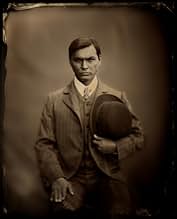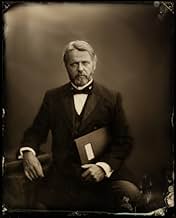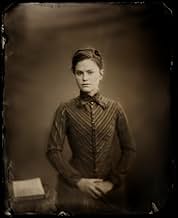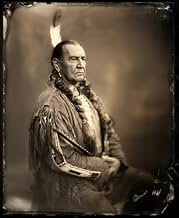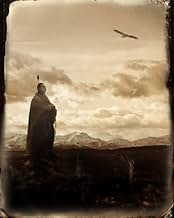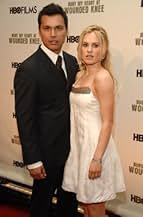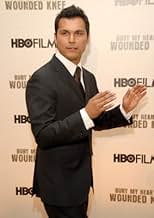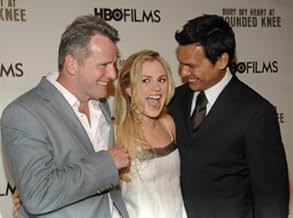Entierra mi corazón en Wounded Knee
Añade un argumento en tu idiomaA historic chronicle based on the book by Dee Brown explains how Native Americans were displaced as the United States expanded west.A historic chronicle based on the book by Dee Brown explains how Native Americans were displaced as the United States expanded west.A historic chronicle based on the book by Dee Brown explains how Native Americans were displaced as the United States expanded west.
- Ganó 6 premios Primetime Emmy
- 29 premios y 31 nominaciones en total
- One Bull
- (as Nathan Chasing Horse)
Argumento
¿Sabías que...?
- CuriosidadesAugust Schellenberg previously played Sitting Bull in both Witness to Yesterday (1973) and Crazy Horse (1996).
- PifiasThe newspaper story being viewed after the Custer battle (Virginia newspaper?) has a dateline of July 3, 1876. The first published account of the event was put out by the Bozeman newspaper (the Times?) on July 4, 1876. Late on July 4, (7:00 p.m.) the Helena newspaper produced a special, extra edition, and at this time, the AP correspondent relayed the material to Salt Lake City, where it was then distributed around the country. The "Virginia" newspaper of the July 3 date could not have contained the story. (Information from searches of archives on the Internet.)
- Citas
Col. Nelson Miles: Sitting Bull requested this council. We await his words.
Sitting Bull: Take your soldiers out of here. They scare the game away.
Col. Nelson Miles: Very well, sir. Tell me, then: how far away should I take my men?
Sitting Bull: You must take them out of our lands.
Col. Nelson Miles: What precisely are your lands?
Sitting Bull: These are the lands where my people lived before you whites first came.
Col. Nelson Miles: I don't understand. We whites were not your first enemies. Why don't you demand back the land in Minnesota where the Chippewa and others forced you from years before?
Sitting Bull: The Black Hills are a sacred land given to my people by Wakan Tanka.
Col. Nelson Miles: How very convenient to cloak your claims in spiritualism. And what would you say to the Mormons and others who believe that their God has given to them Indian lands in the West?
Sitting Bull: I would say they should listen to Wakan Tanka.
Col. Nelson Miles: No matter what your legends say, you didn't sprout from the plains like the spring grasses. And you didn't coalesce out of the ether. You came out of the Minnesota woodlands armed to the teeth and set upon your fellow man. You massacred the Kiowa, the Omaha, the Ponca, the Oto and the Pawnee without mercy. And yet you claim the Black Hills as a private preserve bequeathed to you by the Great Spirit.
Sitting Bull: And who gave us the guns and powder to kill our enemies? And who traded weapons to the Chippewa and others who drove us from our home?
Col. Nelson Miles: Chief Sitting Bull, the proposition that you were a peaceable people before the appearance of the white man is the most fanciful legend of all. You were killing each other for hundreds of moons before the first white stepped foot on this continent. You conquered those tribes, lusting for their game and their lands, just as we have now conquered you for no less noble a cause.
Sitting Bull: This is your story of my people!
Col. Nelson Miles: This is the truth, not legend. Crazy Horse has surrendered... with his entire band. And by his surrender, he says to you and your people that you are defeated. And by ceding the Black Hills to us, so say Red Cloud and the other chiefs, who demand that you end this war and take your place on the reservation.
Sitting Bull: Red Cloud is no longer a chief. He is a woman you have mounted and had your way with. Do not speak to me of Red Cloud!
Col. Nelson Miles: I suppose *you* are the only chief then. Sitting Bull is king of all the Indians! Now, humility is one of the four virtues of the Sioux chief. Sitting Bull shows his true nature now.
Sitting Bull: I have had my say with you.
Col. Nelson Miles: And I have had my say with you.
Sitting Bull: Then we will have a fight.
Col. Nelson Miles: So be it.
- ConexionesFeatured in The 59th Annual Primetime Emmy Awards (2007)
Every movie based on history mixes fact with fiction as filmmakers try to overcome the challenge of morphing complex real-life events into palatable cinema. So let's get the falsities out of the way: Charles Eastman never lived in the Native village near the Battle of the Little Bighorn as young brave Ohiyesa; Sitting Bull surrendered at Ft. Buford, not Standing Rock; lastly, Charles Eastman was not Dawes' associate in developing the Dawes Act.
With that out of the way, what I like about this movie is how balanced it is as it shows both sides of the story. Here the Indians aren't portrayed as super-virtuous with nigh-Messianic powers (except for Wovoka, which is understandable) nor are the whites frothing with evil to massacre the Natives. This balance is perfectly portrayed in the excellent parley sequence between Sitting Bull and Col. Nelson Miles (Shaun Johnston) where honest and intense positions are shared. For instance, Miles argues that North America was anything but a peaceful paradise before Europeans arrived and that the Lakota Sioux conquered other tribes to acquire "their" land in the Black Hills. The Europeans were simply a confederation of several white "tribes" from across the great sea and were merely doing the same thing that Sitting Bull's tribe did – acquiring land from conquered peoples.
Speaking of Sitting Bull, he's one of the most interesting and enigmatic Native characters seen in cinema. And it's a noteworthy performance by Schellenberg.
The Wovoka sequence is another highlight where Wovoka (Studi) brings his prophecy and message of the Ghost Dance to the Black Hills Natives. He articulates his message in a hypnotizing manner accompanied by the sign language of the plains Indians. The irony is that, while Wovoka's vision inspires the Lakota and it replaces their suffering with hope & happiness, it only ends in death.
Two great sequences occur in the final act: The accurately-depicted haunting death of Sitting Bull, which took place on December 15, 1890, at Standing Rock Reservation; and the titular massacre at Wounded Knee Creek on the Pine River Reservation two weeks later. Col. James Forsyth (Marty Antonini) says to Eastman, "We didn't fire first. I swear to Almighty God, we did not fire first," which is verified by history: Tensions mounted in the confrontation as Yellow Bird started to perform the Ghost Dance, informing the Sioux that their "ghost shirts" were bulletproof. Known troublemaker Black Coyote seemed to unintentionally trigger the massacre by refusing to give up his rifle; some say he was deaf and didn't comprehend the order. When two soldiers seized Black Coyote from behind, his rifle was discharged during the struggle. While this was happening, Yellow Bird threw dust in the air and several Lakota braves with concealed weapons threw aside their blankets and fired their rifles at the troops. The firing then became indiscriminate and the massacre entailed.
While "Bury My Heart at Wounded Knee" is a television production, its quality is as good or better than many theatrical pictures. As my title blurb says, it's basically the sequel to 1991's "Son of the Morning Star": That movie ended with Custer's last stand whereas "Wounded Knee" begins with it. Furthermore, they're both televisions productions with the same grueling-realistic tone. Another good comparison is 1975's "I Will Fight No More Forever." It's also not far off in style and approach to movies like "Unforgiven" (1992), "Wyatt Earp" (1994) and "Open Range" (2003). If you're a fan of these types of Westerns be sure to check out "Bury My Heart at Wounded Knee."
The film runs 133 minutes and was shot outside of Calgary, Alberta, Canada.
GRADE: B+
- Wuchakk
- 21 abr 2016
- Enlace permanente
Selecciones populares
Detalles
- Fecha de lanzamiento
- País de origen
- Sitio oficial
- Idioma
- Títulos en diferentes países
- Bury My Heart at Wounded Knee
- Localizaciones del rodaje
- Empresas productoras
- Ver más compañías en los créditos en IMDbPro
- Duración2 horas 13 minutos
- Color
- Mezcla de sonido
- Relación de aspecto
- 1.85 : 1

